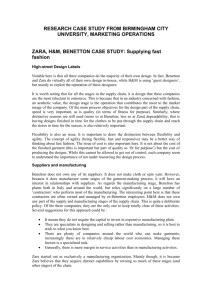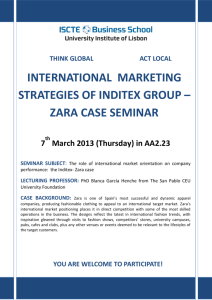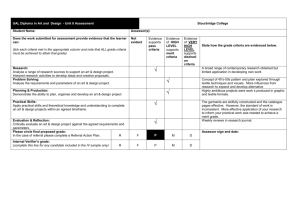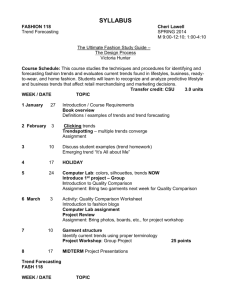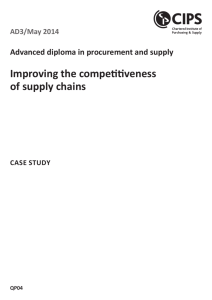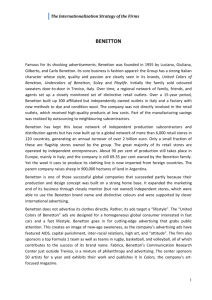Operation Management
advertisement
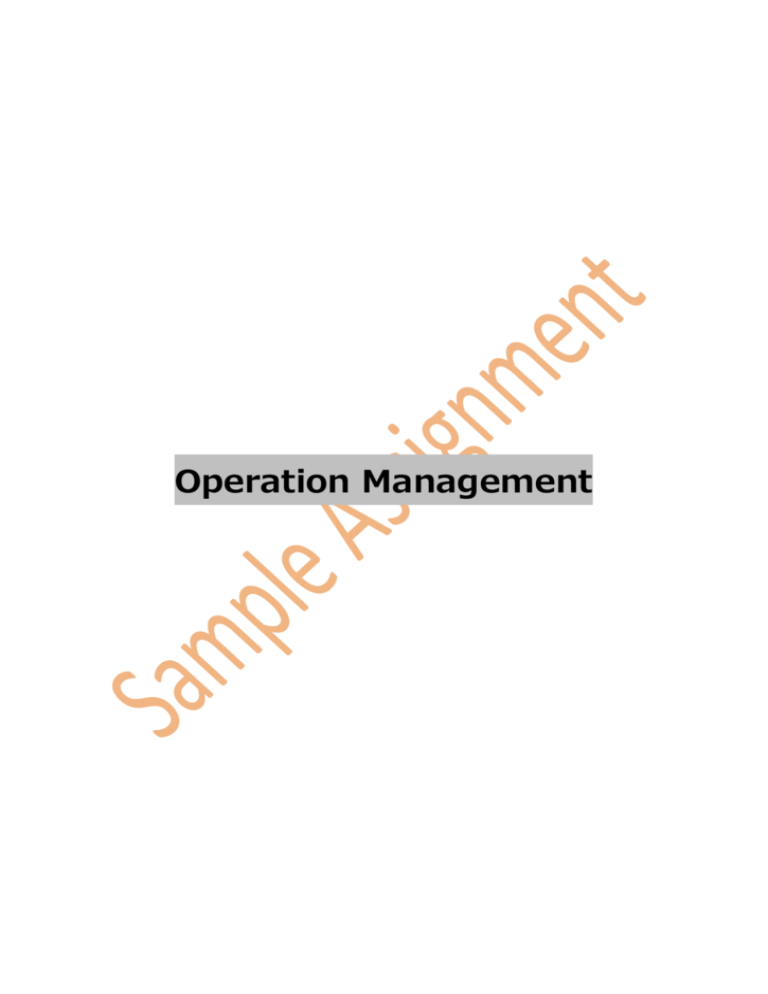
Operation Management Contents Executive Summary: ........................................................................... 3 Introduction: ...................................................................................... 4 Operation Strategy: ............................................................................. 4 Comparison of the Operation Strategy of the organizations: ..................... 6 Comparisons of the Design strategy: ..................................................... 6 Forecasting: ....................................................................................... 7 Short term and long term planning of the organizations: .......................... 8 Forecasting methods has two approaches: ............................................. 8 Quantitative forecasting methods: ......................................................... 8 Innovation and Improvement: ............................................................ 10 Supply Chain: ................................................................................... 11 Quality Management: ........................................................................ 12 Recommendations: ........................................................................... 13 Conclusion: ...................................................................................... 14 References: ...................................................................................... 15 Executive Summary: Current report examines the operation administration process with the assistance of item outline process from beginning to appropriation. The report reveals insight into the foundation of “Benetton, H&M and Zara ", its item outline, promoting procedure, execution administration, venture arrangement and other related points of interest. The report reveals insight into the extent of this business. The creator has clarified in detail the dispatch of item, creation costs, creation time, expenses, and store network administration, advertising and execution examination. Introduction: Operation Management is a challenging solution for the current business world. It is responsible for service and product and it depends upon the environment of the society. Operation management provides the complete understanding of the issues and techniques of the business. Operation management encompasses of Operation Strategy of the organization, Forecasting analysis and reports, innovation and improvement of the plan to implement, supply chain methodology of the organization and quality management. If any one of organization has all these criteria, it will leads to definite growth and it must be a consistent and dynamic. For this case study provide the complete assessment of each and every criterion in Operation management. Operation Strategy: Benetton, H&M and Zara are the stores in the retail market of garments. Up to date, trendy fashionable garments will be provided in a low cost price. Benetton was come up in the market with bright colour fashion of casual sweaters, that was designed by Benetton’s sister and it was very popular in Europe and it spread up across the world. Benetton group has 5000 stores across world in 2005; it is around 120 countries. It manufactures 110 million garments in a year. The revenue of this group is 2 billion euro. They are mainly concentrate on “Higher quality and durability” and but they are compromising their “high fashion strategy” Hennes & Mauritz (H&M) is established in Sweden in 1947; currently it sells garments and cosmetics. All over the world, 1000 stores are in 20 countries. The concept of this business is “fashion and quality at the best price”. In this organization, more than 40,000 employees are working and the revenue generation is around SEK 60,000 million and is the toppest business market of Germany. Zara is the first store open in Amancio Ortega Gaona around the year 1975. It is mainly concentrate on “women’s pyjama manufacturing”. The focus on this shop is for “Outlet for cancelled orders”. All over the world, 1300 stores are in 39 countries. The turnover is 3 billion Euros. In the year of 2003, it reached the stage of “world’s fastest growing volume garment retailer. In the above organizations, they are very clearly concentrated in their market strategy. They have an understandable operation strategy to improvise their business and how to transform their business in the next level. Comparison of the Operation Strategy of the organizations: The operation strategy is nothing but clear understanding of the objective of the performance and regulate with the set of values. Because no organization is start with the plan or design. Like vision and mission, each organization has to concentrate on operation strategy. It plays an important role in the competitive business market. Each organization has unique strategy to improvise their business. Benetton : “Less high fashion; but higher quality and durability” H&M : “Fashion and Quality at the best price” Zara : “Women’s pyjamas manufacturer with the intended only as an Outlet for cancelled orders” The design is the main criteria in the current industry of fashion world. Even though the quality and cost is increased, the impact of designing factor makes difference from organization to organization. Each organization’s operation strategy plays an important role in making their own design of the product. All the three organizations are highlighted their unique design in the business market. Comparisons of the Design strategy: Benetton : 300 designers are in the organizations for designed the Garments. H&M : It recruited the “high-fashion designer”. The team of 50 patterns Designers are working. Zara : It follows the convention approach of designers. That is the Team of buyers, suppliers, designers, market specialist are Working for garment designing. In the above three organizations have some amount of knowledge in operation strategy. But compared to H&M and Zara, Benetton has the less in design strategy. Because fashion design is the very key role in the garments market. Change only is unchanged. Even though they are manufacturing the sweaters, they can implement in the current designers strategies also. Forecasting: Fore casting is about “knowing of options” for the benefits of business using strategy, methodology & reports. It is one of the exploration techniques to avoid the error prone in the organization. Short term and long term forecasting will be maintained to keep away from the ‘trail-and-error’ methodology. Short term and long term planning of the organizations: The Short term plan for these organizations are designing the garments, manufacturing and distributed in the retail market to create the brand value. It’s day to day activity and must be an important goal to maintain the standard. The Long term goal is to sustain the retail garment market with maintenance of consistent growth in uncertainty business market. Maintain the success and growth in the branches of the respective organization. Forecasting methods has two approaches: o Qualitative forecasting methods o Quantitative forecasting methods Qualitative forecasting methods: It’s purely based on the experience of the employees of the organization and decision making by past experience. It educates the designers of the organization even more trendy and how to take predictions in the current scenario. In these considered organizations are more relevant in the qualitative forecasting technique. Quantitative forecasting methods: This method completely depends on the data model of the current organization. Since analyzing the data model with variety of entity will make a profit. Using times series analysis, we can analyze the data trend versus years; it reveals the identify fashion as futuristic thing. We can further divide the Qualitative forecasting methods as, panel approach, Delphi method and scenario planning. Using these approaches, in the above mentioned organizations are making decisions with various strategies. In same while, Quantitative forecasting methods are also further drill down as Times series analysis and Casual modelling techniques. Using these approaches, the organizations are focused on data modelling. It actually provides the Pre-Post analysis on a particular period. Casual modelling is a model of evaluating the multipart phases of issues or difficulties. These organizations are well performed using planning and control of the activities, followed by four overlapping methods: o Loading How much of the work done by the employees. o Sequencing In what order, the work has to do. The progression of the work schedule. o Scheduling Which is the right time to do the work? Maintain the time period. o Monitoring Checking the movement from planning to real time success. Innovation and Improvement: Innovation is nothing but “think outside the box”. The demand versus innovations is direct proportional. Because the demand increased, the innovations also increased and vice versa also. Innovation has to be a main part in the retail market business. To sustain the market and maintain the consistent growth in revenue and reduce the lower cost, innovation is the key solution for business in the market across the world. As per the Benetton, they are focused on their production of the garments in the plant of Italy. Because it automatically the production will be increased outside the Italy, at the same time the labour cost will be very low compared to outside business. This is an amazing innovation by Benetton, for the reason that they are increased their revenues and decreased their labour cost. In H&M, they doesn’t have own factories, 750 suppliers are in this organization around the world. The reason for that, “Less risk of buying the wrong thing”. To sustain the market, quality is very critical factor. Since this organization does not take any risk in quality. Like Benetton, Zara also have it in mind of manufacturing the capital intensive work like cutting and dyeing. Due to volume flexibility, this organization completely involved in the fashion design. Supply Chain: The objective of the supply chain is that to satisfy the end user or customer. The supply chain will meets the requirement from the manufacturing of the garments that is ware house to reach the customer with the latest fashion design. In Benetton and Zara, these organizations have the ware house to manufacturing the garments. They are purchasing the raw material and manufacturing the garments according to the designs and strategies. Then it will be distributed to the buyers for further sale in retail market. In H&M organization does not have the manufacturing unit. Since they have 750 suppliers for the cutting and dyeing. According to this unique design in this organization’s is followed. Customer Relationship Management (CRM) is the one of the main techniques of Supply chain. It analyzes the customer information using information technology. Using this technique, the organization analyse the customer behaviours and maintain the strong relationship with the customer. This is the long term strategy of any organizations. Some of the outline to improve the supply chain: o Right customer with right products o Retaining the existing customer and find out the new customer o Provide the best customer service that is maintain the customer satisfaction o Cross selling the products efficiently and effectively. Quality Management: Quality is one of the main ‘operating criteria’ the good quality of the product, increases the revenue and reduces the cost and improve the customer satisfaction and increases performance compared to other competitors. All these three organisations has the high quality implication is applied. To sustain in the retail market at world level, quality is the high impact. Benetton, H&M and Zara are purposely insisting the ‘high quality’. Even though the garments are in higher prices. These organisations do not consider the ‘higher prices’ as negative criteria. For the reason that, they are very much confidence about their ‘high quality’. This organization has the quality analyst for implementing the ‘high quality’ in their brand. Since these organisations garment performs a ‘world class’ model. The improvisation will be required since; Quality is not a one time achievement. It must be a continuous process to maintain the consistent growth of the brand. Since understanding the quality in operations and customer point of view. Recommendations: Innovations and Improvements are two sides of the coin. Innovation without improvement does not give the result. Ultimate improvement must be adhering by the innovation ideas. There are many approaches can be followed for improvements. Some of the approaches are: o Six Sigma Approach This is considered as the “process control elements” o ‘Innovation-based’ Improvement The key plan is constructed from innovation and makes it in an implementation. Otherwise called thought process o Continuous Improvement It is an incremental performance improvement strategy. Some innovations have to be followed by the particular tenure or strategy. o Improvement Cycles The repeated questioning will be summarized for the improvement. Conclusion: This detailed case study will provide the complete knowledge of Operation management and its criteria’s. In this case study about three organizations that are Benetton, H&M and Zara, the garment organizations. It provides the basic information of these organizations and how the operation strategy and supply chain is performing through CRM techniquies.Acheiving the quality, by carry out the forecasting analysis and Innovation and improvement. Any organization has to aware of these criteria to improve and maintain the consistency and increase revenues and decrease the cost. Many pit falls can be identified and rectified by these methodologies. References: [1] Sources include: press releases, Ryanair; Keenan, S., How Ryanair put its passengers in their place, The Times, 19 June 2002; Flextronics web site. [2] Hayes, R.H. and Wheelwright, S.C. (1984) Restoring our Competitive Edge, John Wiley. [3] For a more thorough explanation, see Slack, N. And Lewis, M. (2008) Operations Strategy, 2nd edn, Financial Times Prentice Hall, Harlow. [4] Mintzberg, H. and Waters, J.A. (1995) Of strategies: deliberate and emergent, Strategic Management Journal, July/Sept. [5] [6] [7] Also called ‘critical success factors’ by some authors. Hill, T. (1993) Manufacturing Strategy, 2nd edn, Macmillan. There is a vast literature which describes the resourcebased view of the firm. For example, see Barney, J. (1991) The resource-based model of the firm: origins, implications Management, vol. 17, no. 1; or and prospect, Journal of Teece, D.J. and Pisano, G. (1994) The dynamic capabilities of firms: an introduction, Industrial and Corporate Change, vol. 3, no. 3. [8] Source: Lifting the bonnet, Economist, 7 October 2006. [9] Weick, K.E. (1990) Cartographic myths in organizations, in A. Huff (ed.) Managing Strategic Thought, Wiley, London. [10] This case was written by Shirley Johnston, 2009. It is basedon a real organization and all names and places have been changed.

